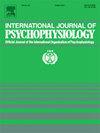Emotional Stroop performance in adults and children with test anxiety: An ERP study
IF 2.5
3区 心理学
Q3 NEUROSCIENCES
引用次数: 0
Abstract
Test anxiety significantly impacts the cognitive performance of both children and adults, yet its specific effects on cognitive processing in response to test-related threatening stimuli across various age groups remain to be fully elucidated. This study employed the emotional Stroop task alongside ERP technology to explore the cognitive processing differences in response to threatening stimuli between children (n = 48) and adults (n = 55) categorized into high and low test anxiety groups. The findings indicated that children, compared to adults, demonstrated reduced accuracy and extended response times in the emotional Stroop task, along with increased ERP amplitudes. Notably, among children with low test anxiety, the N450 amplitude was significantly less negative under the threatening condition compared to the neutral condition. These results contribute to the foundational understanding of the cognitive-neural underpinnings of test anxiety.
求助全文
约1分钟内获得全文
求助全文
来源期刊
CiteScore
5.40
自引率
10.00%
发文量
177
审稿时长
3-8 weeks
期刊介绍:
The International Journal of Psychophysiology is the official journal of the International Organization of Psychophysiology, and provides a respected forum for the publication of high quality original contributions on all aspects of psychophysiology. The journal is interdisciplinary and aims to integrate the neurosciences and behavioral sciences. Empirical, theoretical, and review articles are encouraged in the following areas:
• Cerebral psychophysiology: including functional brain mapping and neuroimaging with Event-Related Potentials (ERPs), Positron Emission Tomography (PET), Functional Magnetic Resonance Imaging (fMRI) and Electroencephalographic studies.
• Autonomic functions: including bilateral electrodermal activity, pupillometry and blood volume changes.
• Cardiovascular Psychophysiology:including studies of blood pressure, cardiac functioning and respiration.
• Somatic psychophysiology: including muscle activity, eye movements and eye blinks.

 求助内容:
求助内容: 应助结果提醒方式:
应助结果提醒方式:


